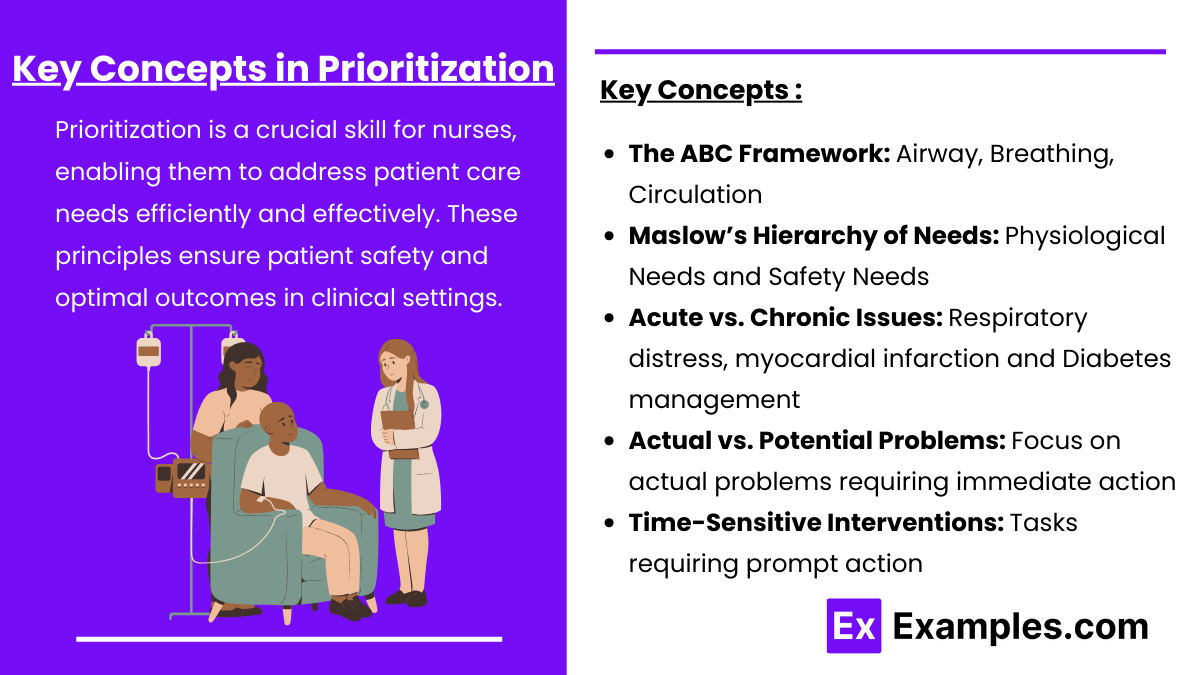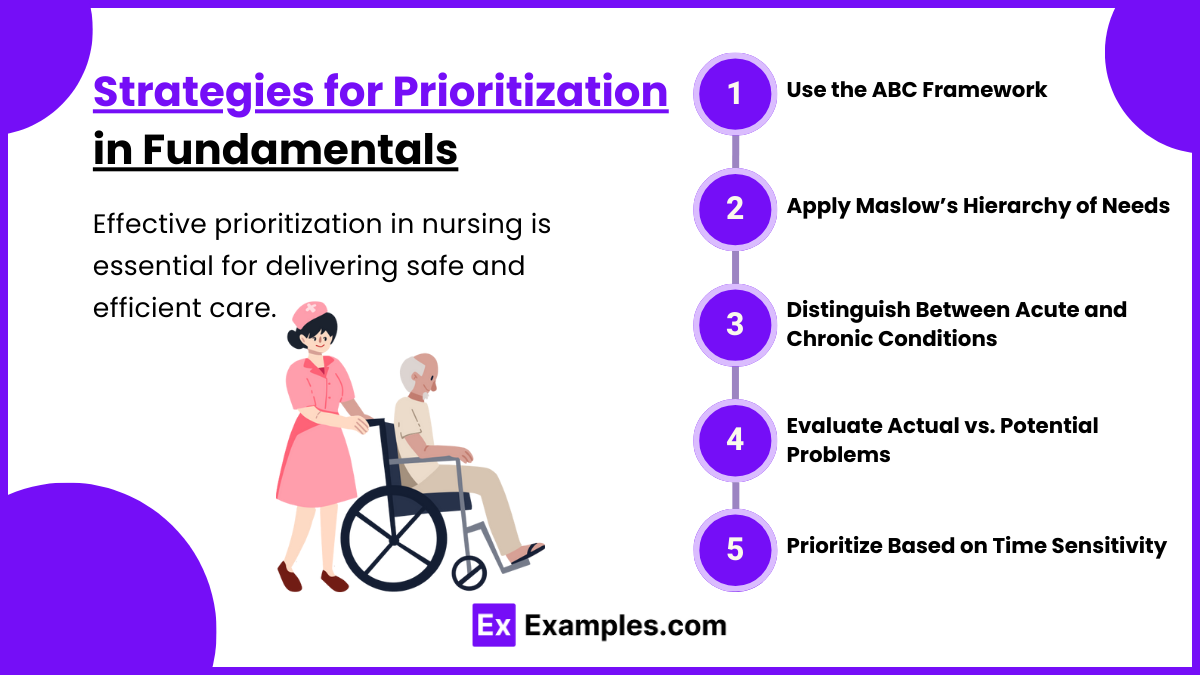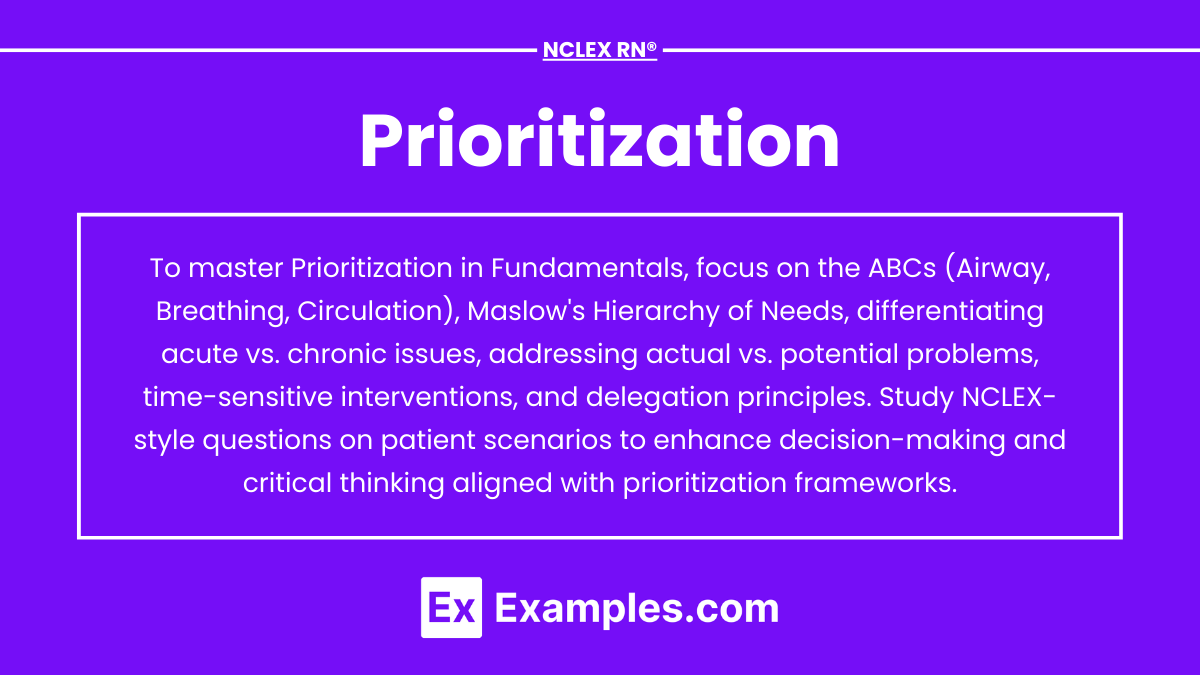Prioritization is a vital skill for nurses, ensuring patient care is delivered effectively and safely. In the NCLEX-RN®, prioritization questions test your ability to identify and address the most critical patient needs using frameworks like the ABCs (Airway, Breathing, Circulation) and Maslow’s hierarchy of needs. These questions challenge you to distinguish between acute and chronic conditions, actual and potential problems, and time-sensitive interventions. Mastering prioritization equips you to make sound clinical decisions, promoting optimal outcomes and enhancing your success on the NCLEX-RN®.
Learning Objectives
In studying "Fundamentals: Prioritization" for the NCLEX-RN®, you should learn to identify and prioritize patient care needs using frameworks such as the ABCs (Airway, Breathing, Circulation) and Maslow’s hierarchy of needs. Understand how to differentiate between acute and chronic conditions, actual and potential problems, and time-sensitive interventions. Evaluate principles of delegation, triage, and resource management to ensure patient safety and optimal outcomes. Explore how prioritization strategies are applied in clinical scenarios and practice interpreting prioritization-based NCLEX-style questions. Apply this knowledge to make critical decisions, manage workload effectively, and enhance patient-centered care in diverse and dynamic healthcare settings.
Key Concepts in Prioritization

Prioritization is a crucial skill for nurses, enabling them to address patient care needs efficiently and effectively. For the NCLEX-RN®, mastering prioritization involves understanding patient acuity, utilizing frameworks like Maslow’s hierarchy, and applying the ABCs (Airway, Breathing, Circulation). These principles ensure patient safety and optimal outcomes in clinical settings. This guide provides comprehensive notes to help you excel in the prioritization questions on the NCLEX-RN® exam.
Key Concepts
1. The ABC Framework
The ABCs (Airway, Breathing, Circulation) are foundational for determining immediate needs.
Airway: Is the airway obstructed? A blocked airway requires immediate intervention.
Breathing: Ensure effective gas exchange. Respiratory distress needs urgent attention.
Circulation: Assess perfusion; prioritize interventions for abnormal heart rate, blood pressure, or bleeding.
2. Maslow’s Hierarchy of Needs
Prioritize care based on physiological and safety needs before addressing psychological or self-fulfillment concerns.
Physiological Needs: Oxygenation, hydration, nutrition, and pain management.
Safety Needs: Preventing falls, ensuring a safe environment, and managing infections.
3. Acute vs. Chronic Issues
Acute conditions (e.g., respiratory distress, myocardial infarction) take precedence over chronic issues (e.g., diabetes management).
Address life-threatening situations before comfort measures.
4. Actual vs. Potential Problems
Focus on actual problems requiring immediate action (e.g., severe hypoglycemia) before addressing potential risks (e.g., risk of falls).
5. Time-Sensitive Interventions : Tasks requiring prompt action, such as administering IV medications or stabilizing a deteriorating patient, take priority.
Strategies for Prioritization in Fundamentals

Effective prioritization in nursing is essential for delivering safe and efficient care. Here are key strategies to master prioritization in nursing fundamentals:
Use the ABC Framework
Always address Airway, Breathing, and Circulation first, as these are critical to sustaining life.
Example: Prioritize a patient with respiratory distress over a patient experiencing mild discomfort.
Apply Maslow’s Hierarchy of Needs
Focus on physiological needs (e.g., oxygen, nutrition, hydration) before addressing safety, emotional, or psychological concerns.
Ensure basic survival needs are met before progressing to higher-level interventions.
Distinguish Between Acute and Chronic Conditions
Acute conditions, such as severe chest pain or respiratory failure, take precedence over managing chronic illnesses like hypertension.
Example: Administer oxygen to a patient with acute shortness of breath before educating a diabetic patient about blood sugar management.
Evaluate Actual vs. Potential Problems
Address current, life-threatening issues (e.g., active bleeding or hypoxia) before focusing on risks or potential complications.
Prioritize Based on Time Sensitivity
Actions requiring immediate attention, such as administering critical medications or managing unstable vital signs, should be performed first.
Examples
Example 1. Managing Respiratory Distress vs. Routine Care
A nurse is assigned four patients: one with respiratory distress exhibiting gurgling breath sounds, one requesting routine pain medication for chronic back pain, one scheduled for a dressing change, and another awaiting discharge teaching. The nurse should prioritize the patient with respiratory distress, as managing airway patency and preventing hypoxia is a life-saving intervention. This aligns with the ABC framework, placing "Airway" as the top priority.
Example 2. Addressing Acute Pain vs. Non-Urgent Concerns
You are caring for a postoperative patient reporting acute chest pain, a patient with a low-grade fever, a stable post-op patient requesting help ambulating, and a patient asking about dietary changes. Acute chest pain may indicate a serious complication like a pulmonary embolism or myocardial infarction. Immediate assessment and intervention for the chest pain take precedence, reflecting the principle of addressing acute over chronic or non-urgent issues.
Example 3. Administering Medications Based on Time Sensitivity
A nurse has several medications to administer: a stat antibiotic for a patient with sepsis, routine oral medications for a stable diabetic patient, an as-needed (PRN) analgesic for mild pain, and preoperative medications for a surgery scheduled in four hours. The nurse prioritizes administering the stat antibiotic to combat the life-threatening condition of sepsis, followed by the preoperative medication to ensure surgery readiness.
Example 4. Prioritizing Safety Over Comfort Measures
During morning rounds, a nurse observes that one patient is confused and attempting to get out of bed unassisted, another is due for a pain assessment, a third is ready for discharge education, and the fourth needs a wound dressing changed. The nurse prioritizes ensuring the safety of the confused patient to prevent falls, which can lead to further complications, demonstrating that safety needs outweigh comfort or educational interventions.
Example 5. Acute Condition vs. Preventative Interventions
The nurse is caring for a patient experiencing severe dyspnea, another with a high risk of pressure ulcers needing repositioning, a third requiring dietary teaching for diabetes, and a fourth asking for assistance with bathing. Severe dyspnea, an immediate and life-threatening issue, takes precedence. After stabilizing the patient, the nurse can address preventative and non-urgent needs like repositioning, teaching, and bathing.
Practice Questions
Question 1
Which patient should the nurse assess first?
A. A 45-year-old client with pneumonia who has a temperature of 101.8°F (38.7°C).
B. A 30-year-old client who reports severe abdominal pain and dizziness after vomiting.
C. A 60-year-old client with COPD who has an oxygen saturation of 91% on room air.
D. A 25-year-old client who is requesting medication for chronic back pain.
Answer: B. A 30-year-old client who reports severe abdominal pain and dizziness after vomiting.
Explanation:
This client exhibits symptoms of potential hypovolemic shock or dehydration due to vomiting and severe abdominal pain. Dizziness may indicate low blood pressure or poor perfusion, requiring immediate assessment to prevent further deterioration.
Option A: While a fever requires attention, it is less urgent than the signs of shock in Option B.
Option C: An oxygen saturation of 91% in a COPD patient is expected and not immediately life-threatening.
Option D: Chronic back pain, while important, is not an acute issue requiring immediate attention.
Question 2
Which intervention should the nurse prioritize for a postoperative client who is experiencing restlessness and has an oxygen saturation of 89% on room air?
A. Administer pain medication for comfort.
B. Apply oxygen via nasal cannula at 2 L/min.
C. Notify the provider immediately.
D. Assess the surgical incision for signs of infection.
Answer: B. Apply oxygen via nasal cannula at 2 L/min.
Explanation:
The client's oxygen saturation of 89% indicates hypoxemia. Applying oxygen is the immediate priority to ensure adequate oxygenation and prevent further complications.
Option A: Pain medication can be administered after the oxygenation issue is addressed, as restlessness could be secondary to hypoxia.
Option C: Notifying the provider is important but comes after the immediate action of applying oxygen.
Option D: Assessing the incision is important but is not the priority when oxygen saturation is critically low.
Question 3
A nurse is caring for multiple patients. Which task should be completed first?
A. Administering insulin to a diabetic client before breakfast.
B. Changing the dressing of a client with a chronic leg ulcer.
C. Monitoring a newly admitted client with chest pain.
D. Educating a client on discharge instructions.
Answer: C. Monitoring a newly admitted client with chest pain.
Explanation:
Chest pain is a potentially life-threatening symptom that could indicate myocardial infarction or another critical cardiovascular issue. Monitoring this client and performing assessments (e.g., EKG, vital signs) is the highest priority.
Option A: Administering insulin is important but can wait briefly as it is a routine intervention.
Option B: Changing a dressing is a lower priority as it does not pose an immediate risk to the client.
Option D: Education can be delayed until the client with chest pain is stabilized.


